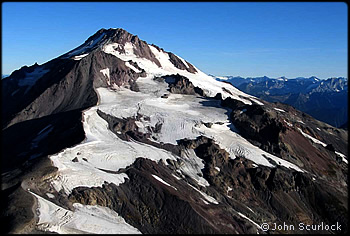 |
 e climbed to a saddle, then looked down at a lake more than a quarter of a mile long fed by the melting Honeycomb Glacier below Glacier Peak. It was September, 2006. I could have sworn that when I was last here, in 1976, the Honeycomb Glacier filled this basin with ice. But now I questioned my memory. After returning home, I searched for and found photographs that proved I wasn’t losing it.
e climbed to a saddle, then looked down at a lake more than a quarter of a mile long fed by the melting Honeycomb Glacier below Glacier Peak. It was September, 2006. I could have sworn that when I was last here, in 1976, the Honeycomb Glacier filled this basin with ice. But now I questioned my memory. After returning home, I searched for and found photographs that proved I wasn’t losing it.
Awareness of climate change in the Pacific Northwest has been growing in recent years. In September 2004, the Wenatchee World ran a story reporting that the South Cascade Glacier, in the heart of the Glacier Peak Wilderness Area, could melt away by the end of the century. Scientists with the U.S. Geological Survey (USGS) who have been monitoring the South Cascade Glacier since 1959 believe that the glacier is now smaller than at any time since the last continental ice age.
Since 1983, teams organized by Nichols College in Dudley, Massachusetts, have been studying glaciers in the North Cascades to measure growth or (more typically) shrinkage each year. Portland State University (PSU) in Oregon is assembling a photographic database of glacier change in the western United States. A research team for the North Cascades National Park surveys glaciers in the park each year. Photographer/pilot John Scurlock, a regular contributor to the Northwest Mountaineering Journal (NWMJ), has taken thousands of aerial photographs of glaciers to support the PSU and Park Service efforts.
The effect of climate change on Northwest mountaineers has attracted the interest of the mainstream media. In May 2007, a crew from Seattle’s KIRO-TV accompanied long-time backcountry skiers from The Mountaineers to record their observations of climate change for a documentary televised on September 19. During the summer of 2007, The Mountaineers ran a series of articles in their monthly magazine about the effects of global warming on Cascade mountaineering.
So, it is fitting that this year’s Northwest Mountaineering Journal should include articles about climate change and glaciers in the Cascades. Mauri Pelto, director of the North Cascades Glacier Climate Project at Nichols College, discusses our vanishing glaciers in a story prepared especially for NWMJ. John Scurlock profiles Austin Post, the self-made glacier expert whose USGS photographs from the 1960s have guided generations of climbers to Northwest summits and have provided a benchmark for visualizing what is happening to our glaciers.
In my own time in the Cascades, I’ve witnessed remarkable shrinkage in the glaciers that make this range unique in the Lower-48. The experts tell us that this will continue and even accelerate in the future. Mountaineers can play an important role in recording and sharing with the greater community the evidence we see of climate change.
Lowell Skoog, editorial team leader
|
 |
|
 |



